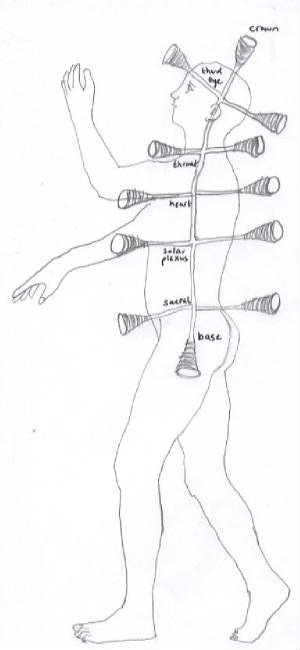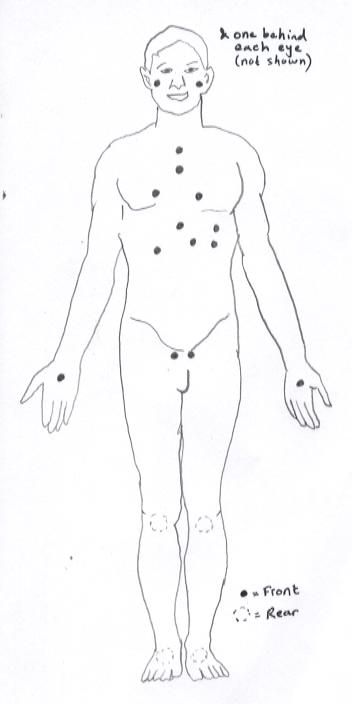|
Back to Reiki
First Degree Reiki Workshop
Second Degree Reiki
About Reiki; workshops, attunements and treatments
What is Reiki?
Reiki is a unique type of healing that is drawn by
the receiver and not sent. The healer acts as a conductor for the reiki to travel through. It is given through the hands by
placing them on (or just above) the body. The healers hands can become warm during a treatment, and the recipient may feel
warmth and it is usually deeply relaxing and soothing. A treatment couch is ideal (like a beauticians or one you would see
in a holistic health clinic). I use a treatment couch when I give treatments but treatments can be given in a seated position
also, or in a hospital bed, on a table with lots of blankets for comfort etc. It is given when the recipient is able to relax
and take time out, and when their attention is not required (e.g. never whilst driving etc).
What is it used for?
Reiki heals and helps all kinds of ills, and can speed
recovery and healing after operations and alleviate pain. In 1999 I had a major accident whereby my two femurs were severely
fractured and my patellas broken. I required major surgery and was in a wheelchair; but only briefly, and was walking
again unaided and back to work (training to be a nurse) within six months. At this time I was trained in Reiki Level
One and Two (since 1998), and used my healing ability for pain relief and to assist the major bone re-knitting that took place.
Today I seldom suffer aches and pains related to my accident, much to the suprise of the surgical team. I use Reiki for
stress relief, headaches, healing situations and relationships, absent healings for others, pain, PMS, injuries, and to aid
digestion. You are only really limited by your imagination. It works differently for each individual, and for those who feel
they may need a lot of treatments, it would be advisable to become attuned to Reiki so they can treat themselves whenever
they want. It works on the physical, mental and spiritual body (e.g. energy centres/ the 'aura'/ chakras etc). If you are
trained in Reiki you are not restricted to treating people; you can treat pets, plants and even inanimate objects. Practitioners
'Reiki' any medication they need to take and even their home and vehicle!
What does a Reiki Treatment Involve?
Usually a Reiki treatment is given with the client
lying down on a massage couch or suchlike and the Reiki practitioner placing their hands on or above certain areas on the
body. The client may be asked to remove jewellary as metal dissipates energy, but clothing remains in place except shoes or
tight belts or anything that would interfere with the clients complete comfort. It is often a deeply relaxing experience;
a real treat. Some clients fall asleep whilst others just enjoy a deep relaxation. I like to softly play relaxing music if
the recipient is happy with this. My treatments last for about an hour. After I have finished giving Reiki I give my client
a glass of water and let them take their time getting up. Reiki can be recieved as a one off treatment or for increased effectiveness
I like to give treatments in 'packages' of between four and six. The first three I prefer to give close together; even on
consecutive days if this is feasible. This is because sometimes people experience what is known as a healing crisis,
where they can feel somewhat worse for a day or two as the energy in their body realigns and toxins are released. This is
perfectly normal and just means the Reiki is doing its job. After the first two or three once weekly would be the normal arrangement,
or whatever fits in with people's schedule.
Is Reiki for me?
Sitauations
When Reiki May Not be Suitable or Caution Should be Exercised:
- If you have Diabetes
Mellitus you should check your blood sugar levels after the treatment, before administering insulin, because Reiki
may reduce the need for so much insulin.
- If you suffer from appendicitis
it is best not to recieve Reiki as energy may accelerate the problem.
- If you have an auto-immune disease and you are on medication that
suppresses the immune system, because Reiki acts to strengthen the immune system.
- It is not safe to be treated
if you are a transplant patient if you have to take anti-rejection medication (these
are drugs work to suppress the immune system).
Reiki is perfectly suitable,
highly beneficial and safe for pregnant women and their babies.
Contrary to some beliefs,
there is no evidence to suggest that Reiki alters the rhythm of a pacemaker, but if in doubt, check with your GP.
What is a Reiki Practitioner?
A Reiki practitioner has been trained and attuned
by a Reiki Master. You cannot learn to give Reiki from a book or distant learning course. There are many books and websites
that publish the sacred symbols (used by Reiki Practitioners at Level Two and above) but nobody can use any symbol that they
have not been attuned to use by a Reiki Master. I have not published any of the sacred symbols on this site for that very
reason.. they are sacred! At level Two a person may give Reiki professionally. Reiki practitioners treat themselves regularly
both for healing themselves and their lives but also to keep the flow of energy strong. the more a person uses Reiki (for
self or others) the more effective the energy becomes for them.
What are the Workshops About?
I teach Reiki Level's One and Two either over a weekend
or as an evening class. I have also taught it one-to-one privately arranging times to suit. Reiki Level One involves four
attunements, and an introduction to Reiki, its history, the seven major chakras, and hand positions for treating
self and others. The main emphasis in Reiki Level One is on treating self, but don't be deterred from treating others.
The Reiki Federation of Ireland recommends that practitioners reach Level Two before taking on clients professionally. Generally
practitioners would feel more equipped to do so having completed Reiki Level Two as well. I advise that you don't consume
alcohol twenty-four hours prior to, and over the weekend/evening of your workshop, in order to get the full benefit. Alcohol
and large amounts of caffeine dissipate energy, but I also respect your autonomy. Listen to your body, as most people
find their appetites change after their attunements, for the better.
What is an Attunement?
An attunement (sometimes called an initiation) is
an ancient and sacred process whereby a Reiki Master uses sacred symbols in which to open up the recipient to the flow of
Reiki. The recipient is seated and the Reiki Master stands, working their way around the student channelling Reiki energy enhanced
by the sacred symbols into various chakras or energy points within the body. It is a very special experience.
What is Absent Healing?
Reiki can be given as absent healings (by Reiki Two
practitioners and above) and the recipient is given a treatment even though they are not physically in the same place.
Distance is no object!
But what about my Religion?
Reiki is Universal Energy and for this reason
it transcends all beliefs and religions. Therefore, it doesn't matter what your spiritual beliefs are if you decide to recieve
or become attuned to Reiki; it is perfectly compatible with your religion. Your faith should enhance your Reiki, and
vice versa.
What are the Chakras:
The chakras are energy centres within and around
our bodies, and there are hundreds of them. In Reiki, we deal primarily with the seven major chakras (see above diagram).
The chakras are associated with specific colours; but this doesn't mean our chakras are always these colours. If they are
balanced and spinning in allignment then these are the colours they are associated with:
Base = Red
Sacral = Orange
Solar Plexus = Yellow
Heart = Green
Throat = Blue
Third Eye = Indigo Blue
Crown = Purple/Violet
Reiki seeks to heal imbalance of the chakras, as well
as physical and emotional imbalance we feel consciously. Yoga also helps to open up the chakras and align them. For various
reasons our chakras can be closed, imbalanced, misalligned, 'dirty' or even spinning the wrong way. The traditional Reiki
hand positions focus on the seven major chakras, and help to correct imperfections.
Different chakras are associated also with different
day-to-day life issues. A brief outline of this is provided below:
- Base = Finances; physical safety; issues
around the home; basic human survival needs.
- Sacral = Sexuality and creativity. Body image.
Addictions and cravings for physical pleasures (including food and drink).
- Solar Plexus = Power and control issues;
fear about being empowered or being overpowered by another; wanting to control another/ others.
- Heart = Love (romantic, familial, platonic, divine,
spiritual). Forgiveness or inability to forgive. Attachments (including unhealthy such as infatuation; co-dependence; unhealthful
relationship addictions). Grief.
- Throat = Communication. Speaking our truth or swallowing
it (including swallowing angry words or not standing up for ourselves). Creativity expression.
- Third Eye = Spiritual and psychic ability (we are all
inherently 'psychic' but learn as we grow up to mistrust our insights and often 'shut down' our abilities due to skepticism
and cultural beleifs).
- Crown = Spiritual connectedness; religion; divine guidance.
The crown can become blocked if we feel anger/confusion towards God or Source.
When our chakras are perfectly balanced we feel great
mentally and physically. Often a blocked chakra can manifest in physical and emotional upset. For your ultimate well-being
learn to look after your chakras. You can do this by recieving Reiki treatments, becoming attuned to Reiki (by doing First
Degree Reiki or above) and treating yourself regularly; through yoga or by chakra balancing meditations/visualisations (as
provided in my Reiki One manual).
Know your chakras, and know how to look after
them.
Side View of the Seven Major Chakras

21 Minor Chakras (these are just some of the minor chakras)

|

